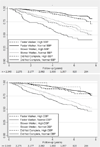Rethinking the association of high blood pressure with mortality in elderly adults: the impact of frailty
- PMID: 22801930
- PMCID: PMC3537835
- DOI: 10.1001/archinternmed.2012.2555
Rethinking the association of high blood pressure with mortality in elderly adults: the impact of frailty
Abstract
Background: The association of hypertension and mortality is attenuated in elderly adults. Walking speed, as a measure of frailty, may identify which elderly adults are most at risk for the adverse effects of hypertension. We hypothesized that elevated blood pressure (BP) would be associated with a greater risk of mortality in faster-, but not slower-, walking older adults.
Methods: Participants included 2340 persons 65 years and older in the National Health and Nutrition Examination Survey, 1999-2000 and 2001-2002. Mortality data were linked to death certificates in the National Death Index. Walking speed was measured over a 20-ft (6 m) walk and classified as faster (≥ 0.8 m/s [n = 1307]), slower (n = 790), or incomplete (n = 243). Potential confounders included age, sex, race, survey year, lifestyle and physiologic variables, health conditions, and antihypertensive medication use.
Results: Among the participants, there were 589 deaths through December 31, 2006. The association between BP and mortality varied by walking speed. Among faster walkers, those with elevated systolic BP (≥ 140 mm Hg) had a greater adjusted risk of mortality compared with those without (hazard ratio [HR], 1.35; 95% CI, 1.03-1.77). Among slower walkers, neither elevated systolic nor diastolic BP (≥ 90 mm Hg) was associated with mortality. In participants who did not complete the walk test, elevated BP was strongly and independently associated with a lower risk of death: HR, 0.38; 95% CI, 0.23-0.62 (systolic); and HR, 0.10; 95% CI, 0.01-0.81 (diastolic).
Conclusions: Walking speed could be a simple measure to identify elderly adults who are most at risk for adverse outcomes related to high BP.
Figures


Comment in
-
Gait speed: comment on "rethinking the association of high blood pressure with mortality in elderly adults".Arch Intern Med. 2012 Aug 13;172(15):1168-9. doi: 10.1001/archinternmed.2012.2642. Arch Intern Med. 2012. PMID: 22801935 No abstract available.
-
Gait speed and high blood pressure.JAMA Intern Med. 2013 Feb 25;173(4):324-5. doi: 10.1001/jamainternmed.2013.1623. JAMA Intern Med. 2013. PMID: 23440238 No abstract available.
-
Hypertension and mortality in the elderly: further insights.JAMA Intern Med. 2013 Feb 25;173(4):325. doi: 10.1001/jamainternmed.2013.1642. JAMA Intern Med. 2013. PMID: 23440239 No abstract available.
-
Walking speed is a useful marker of frailty in older persons.JAMA Intern Med. 2013 Feb 25;173(4):325-6. doi: 10.1001/jamainternmed.2013.1629. JAMA Intern Med. 2013. PMID: 23440240 No abstract available.
-
Walking speed is a useful marker of frailty in older persons--reply.JAMA Intern Med. 2013 Feb 25;173(4):325-6. doi: 10.1001/jamainternmed.2013.2542. JAMA Intern Med. 2013. PMID: 23440241 No abstract available.
References
-
- Institute of Medicine Committee on Public Health Priorities to Reduce and Control Hypertension. A Population-Based Policy and Systems Change Approach to Prevent and Control Hypertension. The National Academies Press. 2010 - PubMed
-
- Franklin SS, Gustin Wt, Wong ND, et al. Hemodynamic patterns of age-related changes in blood pressure. The Framingham Heart Study. Circulation. 1997 Jul 1;96(1):308–315. - PubMed
-
- Aronow WS, Fleg JL, Pepine CJ, et al. ACCF/AHA 2011 expert consensus document on hypertension in the elderly: a report of the American College of Cardiology Foundation Task Force on Clinical Expert Consensus Documents. Circulation. 2011 May 31;123(21):2434–2506. - PubMed
-
- Chobanian AV, Bakris GL, Black HR, et al. The Seventh Report of the Joint National Committee on Prevention, Detection, Evaluation, and Treatment of High Blood Pressure: the JNC 7 report. JAMA. 2003 May 21;289(19):2560–2572. - PubMed
Publication types
MeSH terms
Substances
Grants and funding
LinkOut - more resources
Full Text Sources
Other Literature Sources
Medical

